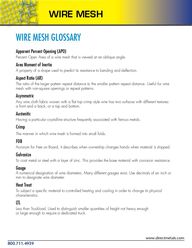
Return to flip book view
WIRE MESH800.711.4939www.directmetals.comApparent Percent Opening (APO)Percent Open Area of a wire mesh that is viewed at an oblique angle.Area Moment of InertiaA property of a shape used to predict its resistance to bending and deflection.Aspect Ratio (AR)The ratio of the larger pattern repeat distance to the smaller pattern repeat distance. Useful for wire mesh with non-square openings or repeat patterns.AsymmetricAny wire cloth fabric woven with a flat top crimp style wire has two surfaces with different textures: a front and a back, or a top and bottom.AusteniticHaving a particular crystalline structure frequently associated with ferrous metals.CrimpThe manner in which wire mesh is formed into small folds. FOBAcronym for Free on Board, it describes when ownership changes hands when material is shipped. GalvanizeTo coat metal or steel with a layer of zinc. This provides the base material with corrosion resistance.GaugeA numerical designation of wire diameters. Many different gauges exist. Use decimals of an inch or mm to designate wire diameter.Heat TreatTo subject a specific material to controlled heating and cooling in order to change its physical characteristics.LTLLess than Truckload. Used to distinguish smaller quantities of freight not heavy enough or large enough to require a dedicated truck.WIRE MESH GLOSSARY
WIRE MESH800.711.4939www.directmetals.comMesh to Diameter Ratio (MD)The wire mesh spacing (center to center) divided by the wire diameter. The MD is used to determine appropriate crimp styles and percent open area.Mesh Spacing, Mesh CountThe repeat pattern of the woven wire mesh. Defined either as a measured distance expressed in inches, or as the number of openings per lineal inch expressed as a count. MetallurgyGeneral science of metalsMill CertsMaterial certification documentsModulus of ElasticityAn elastic modulus, or modulus of elasticity, is the mathematical description of an object or substance’s tendency to be deformed when a force is applied to it. For example, when a light force is applied to a piece of wire, it will deflect differing amounts depending on its material. Aluminum and copper based alloys will deflect approximately three times the amount of steel based alloys. Modulus is different from strength. OpacityThe degree to which a particular wire mesh is opaquePatinaA chemical compound formed on the surface of metalPercent Open Area (POA)The ratio of the hole area to the total screen area at a 90° angle of incidence to the plane of the material, expressed as a percentage. Percent open area helps in comparing various materials as to how readily a substance, whether it is liquid, air or light, passing through the screen.PicklingImmersing metals in a solution to remove surface scale and oxidation.ScaleThe ability to create larger or smaller wire mesh weaves without changing any proportions or crimp styles.
WIRE MESH800.711.4939www.directmetals.comShute (Or Fill Wires)The wires perpendicular to the direction in which the fabric is being woven.StiffnessResistance to deflection by an applied force. How firm or springy an object feels.StrengthMeasured by how much load a piece of wire mesh can withstand before:a) Permanent bending (yield strength)b) Breaking (tensile strength)StriationA thin line or band, especially one or several close together.Warp WiresThe wires parallel to the direction in which the fabric is being woven.